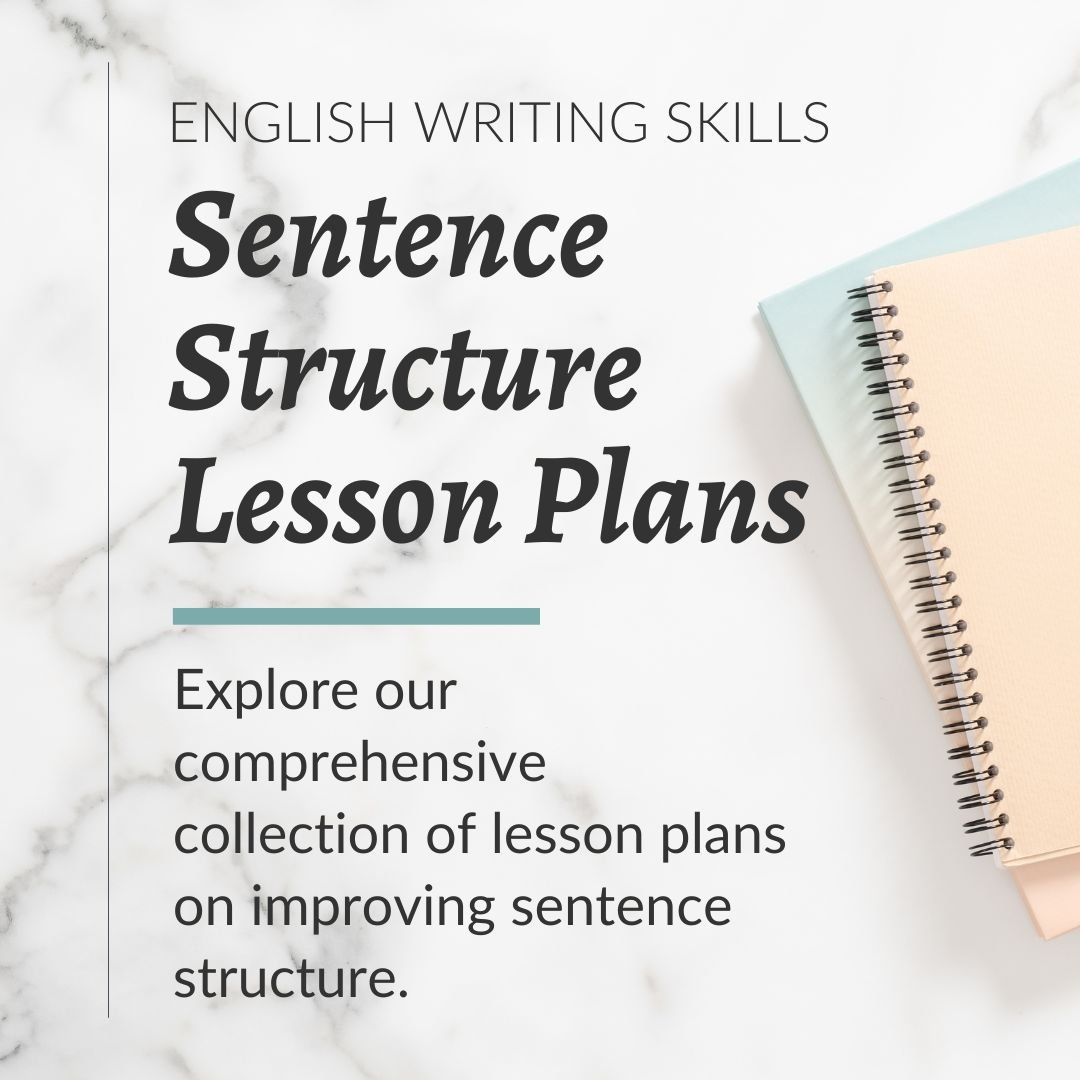Improving Sentence Structure in English with Exercises
If you’re an English learner who has reached a more intermediate or advanced level, you might have noticed that you’ve made a lot of improvement, but you still want to improve your sentence structure.
First of all, the fact that you’re even aware of this issue is a good thing! It means that you’ve gotten a better understanding of the language and its structures. Still, you’ve been making steady progress, and you want to keep moving forward.
So, you’d like to focus on improving your sentence structure, but you don’t know where to start. Well, that’s what we’re going to talk about today!
Today, we’ll take a look at four things that English learners can do in order to improve their sentence structure:
Practice using relative clauses
Practice using compound sentences
Practice using complex sentences
Practice using the active and passive voice
We’ll also explore some practice exercises that you can use to improve in each of these areas.
So, if you’re ready to learn some strategies that can help you with your speaking and writing, let’s get started!
Improving Sentence Structure
Master the most challenging sentence structures in English: Compound & complex sentences, conditionals, the passive voice, relative clauses and reported speech.
HOW TO IMPROVE SENTENCE STRUCTURE IN ENGLISH
Practice Using Relative Clauses
I’ve talked a bit about different types of clauses in another post, but I didn’t talk about relative clauses. So, what are they?
A relative clause is a clause that starts with a word like who, which, that, why, where, when, and whose, and we use them to describe nouns. You’ve probably learned about them in school, and you’ve heard people use them on plenty of occasions, but you may not know how to use them yourself.
Let’s take a look at these two sentences. Neither one has a relative clause.
This meal reminds me of another meal. My grandmother used to make a meal just like this.
We can simplify this idea with a relative clause, like this:
This meal reminds me of another meal that my grandmother used to make.
Here are a couple more examples:
I’m looking for the student whose mother called yesterday.
The novel, which he wrote in two months, quickly became popular.
Did I tell you about the customer who gave us a bad review?
The tricky thing to remember about relative clauses is that there are actually two kinds: a defining relative clause and a non-defining relative clause. In order to figure out which one is which, just ask this simple question: If you take out the relative clause, does the meaning or structure change?
With a defining relative clause, the answer is yes. The information in a defining relative clause is essential and needs to be included in the sentence. For example, look what happens when I leave out the relative clause in this sentence:
I’m looking for the student.
You’ll notice that the sentence needs more information. So, the relative clause “whose mother called yesterday,” is a defining clause because it’s necessary for the sentence to make sense.
However, in this sentence, notice what happens when I leave out the relative clause:
The novel quickly became popular.
If I add the relative clause “which he wrote in two months” after the word “novel,” it doesn’t change the main idea of the sentence. The sentence makes sense without this extra information, so in this situation, we consider this a non-defining relative clause.
Keep in mind that when you write with a non-defining relative clause, you have to separate it from the rest of the sentence with commas.
The novel, which he wrote in two months, quickly became popular.
We laughed so much that day, which we had never done before.
Istanbul, where my cousin lives, is known for its beautiful mosques.
NOTE: Sometimes English speakers will leave the relative pronoun (such as who, which, or that) out of the relative clause. For example, we can remove the word “that” from this sentence, and it’s still correct:
He can’t stop talking about the movie that he saw last week.
Practice Exercise
Combine the two sentences together using a relative clause. (a clause beginning with which, that, who, where, or when). Then circle whether circle the word ‘defining’ if you used a defining clause or ‘non-defining’ if you used a non-defining clause.
My best friend lives in Michigan. She has ten siblings.
(defining or non-defining?)
The man cooked all of this food. He’s standing in the back of the room.
(defining or non-defining?)
The family travels nine months out of the year. This is their house.
(defining or non-defining?)
She never showed up to her own party. It shocked us all.
(defining or non-defining?)
Let’s go somewhere for the weekend. This place should be cheap and close by.
(defining or non-defining?)
Practice Using Compound Sentences
If you’ve noticed that you use too many simple sentences, as I said before, that’s a good thing! It shows you’re making progress. But, even if you haven’t notice that you use too many simple sentences, that’s okay. We’re going to talk about other kinds of sentence structures you can use.
So, let’s talk about compound sentences and how you can practice with them.
A compound sentence is a sentence that combines two independent clauses - or clauses that have a subject and verb and can work on their own as a sentence. And how do you combine them? You combine them with a coordinating conjunction such as “and,” “or,” “but,” or “so.” Some people find it helpful to use the acronym FANBOYS to remember all of the coordinating conjunctions (for, and, nor, but, or, yet, so).
Let me use this example to show you how we can vary our sentences by combining two simple sentences into one compound sentence.
She moved to the city. She’s not happy there.
She moved to the city, but she’s not happy there.
In the first example, we have two simple sentences that show contrasting ideas. When we combine them in the second sentence, we use the word “but” to show how these two ideas contrast each other. You’ll notice that we have to put a comma before the conjunction. Now let’s look at another example:
He drank too much at the restaurant. I offered to drive.
He drank too much at the restaurant, so I offered to drive.
In this example, we use the conjunction “so” to show that one idea is the result of the other.
We can go to the Mexican restaurant. We can go to the Italian restaurant.
We can go to the Mexican restaurant, or we can go to the Italian restaurant.
Here, we have to use the word “or” to emphasize that we only have two choices, and both are equal.
Practice Exercise
Combine the two sentences together using the conjunction and, or, so, or but.
He loves that band. He hates their new album.
My wife loves to cook. She makes delicious food.
They forgot to water their garden. All the plants died.
We can take the train into the city. We can drive the car there.
She loves riding her bike to the park. Lately, she hasn’t had the time.
Practice Using Complex Sentences
They might sound intimidating, but a complex sentence doesn’t mean a sentence is complicated.
Unlike a compound sentence, a complex sentence combines an independent clause and a dependent clause - or a clause that cannot stand on its own as a sentence.
But, similar to compound sentences, the main thing to remember here is the conjunction. In a complex sentence, we use a subordinating conjunction such as “because,” “if,” “unless,” or “even though.”
Keep this in mind: the dependent clause is just the clause that begins with the subordinating conjunction.
Let’s take a look at how you can combine two simple sentences to create a complex sentence.
He was late for the party. He ran into some traffic on the way.
He was late for the party because he ran into some traffic on the way.
In the second sentence, the clause “because he ran into some traffic on the way” is considered a dependent clause. Did you notice how there’s no comma in this sentence? If the sentence starts with an independent clause, you don’t need a comma.
Let’s take a look at another example.
She was really exhausted. She agreed to read her son a bedtime story.
Even though she was really exhausted, she agreed to read her son a bedtime story.
Did you notice how we started the second sentence with the dependent clause “even though she was really exhausted?” If we start the sentence with a dependent clause, we have to put a comma after the dependent clause.
Let’s take a look at one more example before you get into the practice exercise.
We’ll invite him on the trip. He has to promise us he’ll behave.
We’ll invite him on the trip if he promises he’ll behave.
You might notice something interesting here. In this case, we can’t say “if he has to promise us,” because the condition is “he has to promise us.” An if-clause is also a conditional clause, so you have to be careful about how you use it.
Practice Exercise
Unscramble the complex sentence so that it makes sense. You might have to add punctuation and capitalize one of the words.
make time to practice / you’ll never get better at guitar / unless
you sweep the floor / I’ll wash the dishes / if
he still wants dinner / he ate all those snacks / even though
her roommate went for her / she didn’t go to the store / because
he drinks milk / his stomach gets upset / if
Practice Using the Active and Passive Voice
You might have learned about the active voice and passive voice in school, but do you feel comfortable using them?
Remember that with the active voice, we start the sentence with the subject of the sentence, the “doer” or “actor.” And with the passive voice, we start the sentence with the object - or the thing that is receiving the action.
So, understanding the difference between them and how to use them will help you improve your sentence structure in both speaking and writing.
One important clue that can help you identify the passive voice right away is the verb “be” or any conjugation of that verb, such as “is,” “was,” “are,” “were,” “is being” or “has been.”
Take a look at these examples of the passive voice:
The suspect was arrested by the local police at 11:00 pm last night.
My brother has been accepted to university.
Our new house is currently being built.
Now let’s take a look at the same sentences, but this time in the active voice:
The local police arrested the suspect at 11:00 pm last night.
The university accepted by my brother.
They are currently building our new house.
There are certain times when it makes more sense to use the passive voice, such as in academic or formal writing, or when we don’t know the subject, or when we don’t want to talk about the subject specifically.
But most of the time, it’s better to write in the active voice because it’s clearer and more direct.
Practice Exercise
Decide if the sentence is passive or active. If it’s passive, write it in the active voice. If it’s active, write it in the passive voice.
That house was built by a famous architect.
They are preparing your food for delivery.
Did it feel like they were watching us?
The movie was inspired by real events.
We made a mistake when we were processing your plane ticket.
What else can you do to improve your sentence structure?
If you’re wondering what else you can do to make your sentence structure better, you can try to create your own practice exercises similar to these. Try making the goal with yourself to do some kind of practice exercises every day, even if it only takes ten minutes of your time. It might feel like you’re not making much progress at first, but I promise you are!
If you want to mix it up, challenge yourself to write about an experience from your past, or write a short story or poem.
And if you’re looking for inspiration, or you just need materials for self-study, I highly recommend checking out these lesson plans we designed specifically to help you practice what you learned here and become more confident with your English writing skills.
Just be sure to choose something that works for you and that will make you want to work on your speaking and writing regularly. Every little bit of practice counts!
About the writer
Marta is an online ESL teacher who works with students from around the world. As a writer, language nerd, and content contributor for In English With Love, her mission is to empower English learners with knowledge and positivity.

















